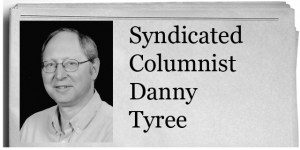Mark Millican: Watch what you eat — and play on!
Published 7:00 am Tuesday, January 21, 2025

- Mark Millican
An ingredient in cosmetics that was banned in 1990 by the U.S. Food and Drug Administration (FDA) has finally been forbidden in the food we eat (red dye No. 3).
Why was it banned from cosmetics? “The FDA itself determined that the dye causes cancer when eaten by animals,” states the Center for Science in the Public Interest, a watchdog nonprofit group that advocates for health and consumer protection.
Trending
However, it took decades for the FDA to ban the dye from foods, beverages, oral drugs and dietary supplements. Again, from the Center for Science in the Public Interest: “Because the FDA failed to uphold its legal obligation to fully ban cancer-causing additives, Red 3 remained permitted in foods, supplements and oral drugs more than 34 years later.”
As stated in a recent NBC News article, “The dye is still used in thousands of foods, including candy, cereals, cherries in fruit cocktails and strawberry-flavored milkshakes. More than 9,200 food items contain the dye, including hundreds of products made by large food companies, the Center for Science in the Public Interest said, citing (U.S.) Agriculture Department data.”
That includes seasonal candies that particularly need a red color, such as those gobbled up at Halloween and the upcoming Valentine’s Day. Feeling woozy yet?
“Common products include (Valentine) conversation hearts, cherry cordials, candy corn, PEZ, original Dubble Bubble gum and some flavors of Ringpop,” reports Yahoo! News.
However, couldn’t the same delayed warning of harmfulness also be applied to cigarettes? After all, it wasn’t until the 1940s and ‘50s that links were being made between cigarette smoking and lung cancer, and the U.S. Surgeon General didn’t announce the link officially until 1964 for a practice that began in the colonial days of our nation. Smoking was banned on domestic airline flights in the late 1980s, and then in most of Georgia’s restaurants in 2005, thanks to the efforts of the late state senator and family physician Don Thomas of Dalton.
Frankly, I can’t believe people still puff on the darn things as much as they’re exorbitantly taxed. When I stood behind a woman at a convenience store recently and watched her fork over $9 for a single pack of smokes I almost coughed!
Trending
But I digress. Let’s pivot to an increasingly-used product by our children and grandkids. Peter Funt, a national newspaper columnist and son of Allen Funt of “Candid Camera” TV show fame, penned a recent column on artificial grass.
“Some chemicals in the rubber base of synthetic turf, such as bisphenol A, commonly known as BPA, can leach out during extreme heat,” he stated in a column that appeared in a recent issue of the Dalton Daily Citizen. “These chemicals have been linked to various chronic diseases including cancers, diabetes and neurological impairments … Many of the efforts (to ban artificial turf) have been driven by revelations surrounding the risk factors of chemicals associated with plastics like those used in fake grass.”
Bottom line, we live in a dangerous world — even when we’re blissfully unaware of it. In closing, let’s return to food. In 1990, a federal law was strengthened that required the listing of food ingredients on food packaging. It has been suggested by some nutritionists that if a product contains more than five or six ingredients you have trouble pronouncing you probably shouldn’t consume it (check your protein drink additives).
So should food labels spell out exactly what each specific ingredient may do to your body, like packs of cigarettes? Is that too much government oversight? You decide. After all, reports NBC News regarding red dye No. 3, “Food manufacturers will have until Jan. 15, 2027, to reformulate their products. Companies that make ingested drugs, such as dietary supplements, will get an additional year.”
So in the meantime, here’s to your (hopefully watchful) health in 2025!
Mark Millican is a retired newspaper editor and former staff writer for the Dalton Daily Citizen who splits his time between Varnell and Ellijay.





